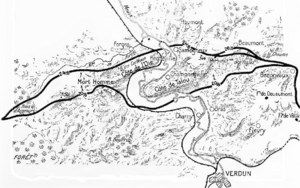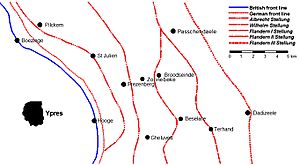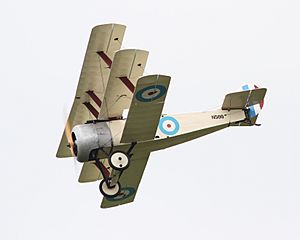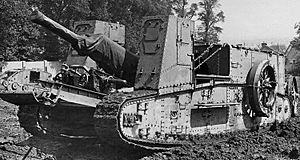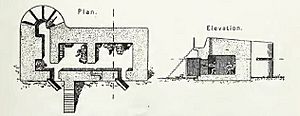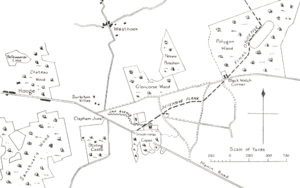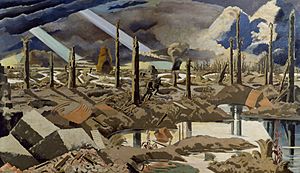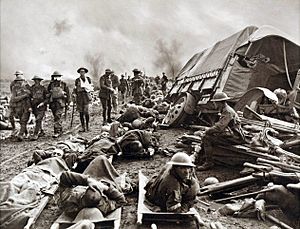Gheluvelt Plateau actions, July–August 1917 facts for kids
Quick facts for kids Gheluvelt Plateau actions, July–August 1917 |
|||||||
|---|---|---|---|---|---|---|---|
| Part of the Third Battle of Ypres in the First World War | |||||||
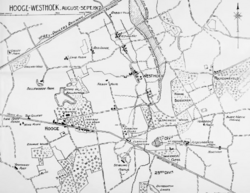 Gheluvelt Plateau: Inverness Copse, Westhoek and Glencorse Wood |
|||||||
|
|||||||
| Belligerents | |||||||
| Commanders and leaders | |||||||
| Strength | |||||||
| II Corps | Gruppe Ypern | ||||||
The Gheluvelt Plateau actions were a series of battles that happened from July 31 to August 27, 1917. These fights were part of the larger Third Battle of Ypres during the First World War in Belgium. The British Fifth Army and the German 4th Army fought for control of the Gheluvelt Plateau. This plateau was the highest point of the ridges around Ypres in West Flanders.
The German army had been building strong defenses in the Ypres Salient since 1915. The Gheluvelt Plateau was the most heavily protected part of their front line. The British Fifth Army wanted to capture the plateau. However, their first attack, the Battle of Pilckem Ridge, did not fully succeed. German counter-attacks even took back some land.
Heavy rains started on July 31 and lasted until August 5. This turned the battlefield into a sea of mud and flooded shell craters. An attack by the British on August 10 led to the Capture of Westhoek. But the Germans quickly recaptured areas like Inverness Copse and Glencorse Wood. Even with new tactics, the German success came at a high cost in soldiers. The Royal Flying Corps (British air force) flew more missions. They watched the battlefield and attacked ground targets. However, a quick German counter-attack forced some British troops to retreat.
On August 22, the British 14th (Light) Division captured Inverness Copse. But the Germans took it back on August 24. A tank and infantry attack failed on August 27. The tanks got stuck in the mud. The wet ground made all movement hard. It also made tank operations almost impossible. Shell explosions were also muffled by the mud. Low clouds and fog made it hard for soldiers to communicate. This also affected how British artillery worked with their observation planes.
Even though the British tried new tactics, the German defenders held on. They faced the same tough conditions. British morale dropped very low. Some soldiers were even captured without a fight. The Germans found them upset about their failures. However, the German 4th Army also suffered many casualties.
After August 24, Field Marshal Sir Douglas Haig, the British commander, changed the army boundaries. He moved the British Fifth Army–Second Army line north. He replaced the II Corps with fresh troops. After a three-week break, the rains stopped and the ground dried. The British then captured much of the Plateau on September 20. This happened during the Battle of the Menin Road Ridge.
Contents
- Why the Battle Happened
- The Battle Begins
- German Defenses
- British Attack Plans
- July 31: The First Push
- August 1–9: Rain and Delays
- August 10: Capture of Westhoek
- August 11–15: More Delays and Reinforcements
- August 16: Battle of Langemarck
- August 17–19: Analyzing the Failures
- August 22–24: Fighting for Inverness Copse
- August 25–31: Final Actions
- After the Battle
- Images for kids
Why the Battle Happened
The Land and Its Importance
Ypres is a city surrounded by low hills. To the southwest is Kemmelberg (Kemmel Hill). To the east are hills with places like Hooge and Passchendaele. These hills are not very high. The highest point is Wytschaete, about 150 feet above the plain. The land around Ypres looks like a saucer.
Controlling the higher ground was very important for the Germans. It gave them a clear view of the British positions. They could easily direct their artillery fire. They could also move their soldiers and supplies without being seen. The ridges had woods like Polygon Wood. By 1917, these woods were mostly destroyed by artillery. They became a mess of tree stumps and shell-holes. The roads were mostly unpaved. The lowlands to the west of the ridge were wet and muddy.
Bigger Picture: Other Battles
By August 1917, only two US army divisions had arrived in France. The French army had faced some problems after the Nivelle Offensive. But these issues were getting better. The French launched the Second Battle of Verdun on August 20. This was to help the British in Flanders. The French captured Mort Homme and Hill 304. They took 11,000 prisoners. The German 5th Army could not launch big counter-attacks. Many of their special counter-attack divisions had been sent to Flanders.
On the Eastern Front, the Russian armies were falling apart. This allowed Germany and Austria-Hungary to send more troops to other fronts. In the south, the Italian army began the Eleventh Battle of the Isonzo on August 17. They captured the Bainsizza Plateau. This made the Austro-Hungarians ask Germany for help.
British Plans and Preparations
The British commander, Field Marshal Sir Douglas Haig, wanted to build on the success of the Battle of Messines in June. He wanted to capture the Gheluvelt Plateau. This was a key step before a larger attack out of the Ypres Salient. General Hubert Gough, who led the Fifth Army, was in charge of this attack.
The British planned their attacks carefully. They used a lot of artillery. Infantry soldiers were trained to follow a "creeping barrage." This was a moving wall of artillery fire. They would stop at certain points to reorganize. Then they would dig in at their final goal. New training methods helped soldiers know what to do. They learned to use their own initiative.
The British also improved their communication. They used visual signals, carrier pigeons, and even early wireless sets. This was important because voice communication was often impossible during battle.
The Battle Begins
German Defenses
The German 4th Army defended the front line from Lille to the North Sea. This included the Ypres Salient. The Germans had a system called "defense in depth." This meant they had several lines of defense. The first line had strong points and breastworks. About 2,000 yards behind this was the forward battle zone. Further back were more lines, including the Flandern Position.
Because the ground was flat and wet, the Germans built many concrete pillboxes and blockhouses. These were above ground and hidden with mud and grass. They could hold many soldiers and were very strong. German commanders debated whether to retreat to stronger lines. But they decided to hold the front line firmly. They believed in immediate counter-attacks to take back any lost ground.
German infantry also got new machine guns. This gave them more firepower. They formed special "storm troops" to counter-attack. These troops were trained to move quickly and attack.
British Attack Plans
The British II Corps was to attack on a wide front. They aimed to capture three main objective lines. These lines were just beyond the German front system. The final objective, the "green line," was about 1,000 to 2,500 yards forward. Small groups of fresh troops could push further if the Germans were weak.
The British planned to destroy German strong points and cut barbed wire with artillery. They also tried to stop German artillery from firing. The infantry would follow the creeping barrage. Tanks were also supposed to help. However, the woods on the plateau hid many German strong points. Bad weather also made it hard for British planes to see these defenses.
The 30th Division had the hardest job. They were supposed to attack the Gheluvelt Plateau. This area was very important to both sides. The Germans were expected to counter-attack quickly.
July 31: The First Push
The British II Corps attack started at 3:50 a.m. It was still dark due to low clouds. The British 24th Division attacked on the right. They tried to create a defensive flank. The 17th Brigade reached its objective. But the 73rd Brigade was stopped by German pillboxes. The 72nd Brigade also faced heavy machine-gun fire and had to pull back.
The 30th Division also struggled. Their soldiers were late reaching the start line. They were weighed down by equipment. They also had to move through destroyed woods and shell craters. When they reached the edge of Sanctuary Wood, German machine guns stopped them. It took hours to capture the ridge. By then, the creeping barrage had moved too far ahead. Attempts to advance further failed. Communication was also very difficult. Telephone lines were cut, and visual signals were hard to see in the bad light.
The 8th Division attacked towards Westhoek. They captured Bellewaarde Lake. But they also struggled to keep up with the barrage. They faced heavy machine-gun fire from Glencorse Wood. They could not hold their new front line south of Westhoek. German counter-attacks forced them back. By 1:30 p.m., the II Corps attack had stopped.
Air and Tank Support
Bad weather on July 29 and 30 limited British air operations. On July 31, low clouds and fog stopped most air support. British planes flew low to see troop movements. Many planes were damaged by bullets and shells. Some reports from the planes did not reach headquarters.
The tanks also faced problems. The ground was not prepared for them. Several tanks were hit by German anti-tank guns. Many got stuck in the mud or broke down. Some tanks did manage to destroy machine-gun nests. But they could not hit the hidden German concrete bunkers. Of 48 tanks, 22 got stuck or broke down. Only 19 saw action.
August 1–9: Rain and Delays
After July 31, the British realized they needed to secure the Gheluvelt Plateau. The German artillery was still very strong. Heavy rain continued for three days. The ground became a huge swamp. Streams turned into bogs. Roads were covered in deep mud. This made it very hard to move soldiers and supplies. Both sides were quickly exhausted.
The British postponed their next attack several times. The weather remained bad. German commanders were worried about their soldiers getting tired. Divisions were suffering many casualties. Especially from gas attacks. The next attack was finally set for August 10.
August 10: Capture of Westhoek
Many German pillboxes were still intact. But the British troops, following the creeping barrage, quickly overran the first German defenses. The ground was full of flooded shell holes. In Glencorse Wood, smashed trees lay in oozing mud. Many German defenders surrendered.
However, the British faced strong resistance from Inverness Copse. Machine-gun fire stopped them. German counter-attacks forced the British back in some areas. The British 54th Brigade captured its objectives. But they were isolated by German artillery fire. The 74th Brigade also advanced well. They captured Westhoek village and two blockhouses. But German artillery fire continued all day. Snipers and German planes also caused many losses.
The British managed to hold Westhoek. But they could not dig continuous trenches. German counter-attacks continued into the night. The British 25th Division suffered many casualties.
August 11–15: More Delays and Reinforcements
After the August 10 attack, British commanders realized their artillery support was not enough. They also needed more air reconnaissance. The ground was still very bad. German artillery continued to destroy British supply routes. The British brought in fresh divisions. But these new troops quickly became exhausted by the conditions.
The British commander, Gough, was also under pressure. He needed to coordinate with a naval operation (Operation Hush) that depended on high tides. This meant he couldn't delay the main offensive for too long. However, after more thunderstorms on August 14, the attack was postponed again until August 16.
August 16: Battle of Langemarck
The British II Corps planned to capture the German Wilhelmstellung line. This was an advance of about 1,500 yards. The British barrage started at 4:45 a.m. The infantry followed. German SOS flares went up, but their artillery response was too late in most areas.
However, on the right flank, the British 56th Division lost many men to German artillery. They were also stopped by heavy machine-gun fire from Inverness Copse. A key pillbox there had a wide firing range. In the center, the 169th Brigade advanced quickly. They captured pillboxes in Glencorse Wood. But they lost the barrage and faced more German machine guns.
The 167th Brigade also started fast. But they found mud 4 feet deep. This caused a gap in the British lines. German troops exploited these gaps. They surrounded British battalions. The British were forced back to their starting lines in some areas.
On the 8th Division front, they reached the Hanebeek stream. They captured several German strongholds. But German machine guns from the north and south caused problems. German counter-attacks forced the British back. By evening, the British were ordered to retreat close to their starting lines. The German commander, Rupprecht, noted that his army group had suffered many casualties. He believed the 4th Army could only make small attacks.
August 17–19: Analyzing the Failures
After the Battle of Langemarck, British commanders discussed what went wrong. They said there wasn't enough time to prepare. They also noted that the protective artillery barrage was not effective. Many shells did not explode properly in the soft, wet ground.
The British 56th (1/1st London) Division had 2,175 casualties. The 8th Division lost 2,111 men. Both divisions were replaced by fresh troops. The new divisions had to occupy fortified shell holes. German artillery observers had a good view. Any movement by the British was met with artillery fire.
August 22–24: Fighting for Inverness Copse
By late August, Inverness Copse was held by German troops. It was a vital outpost. The Germans were ordered to hold it at all costs. Capturing it would give the British important observation points. The British planned to capture the eastern edge of Inverness Copse.
On August 22, the British 43rd Brigade attacked. The 6th Somerset Light Infantry entered Inverness Copse. They fought hand-to-hand with German soldiers. They slowly pushed the Germans back. They captured 60 prisoners. But the British unit was also heavily reduced.
One of four tanks supporting the attack helped the British. It engaged German pillboxes. It forced German defenders out of a trench. But German artillery eventually knocked out the tank. The British 6th DCLI could advance a little further. But they were still short of their goal.
German counter-attacks pushed the British back to the western edge of the Copse. The Germans brought in more troops. On August 23, the Germans launched another attack. It coincided with a British attack supported by five tanks. Three tanks got stuck. The other two engaged German defenses. But they were also knocked out by German artillery.
On August 24, the Germans launched a methodical counter-attack. Their artillery barrage fell short, hitting their own positions. The German infantry advanced anyway. They faced heavy British fire. Some German groups reached their objective. But they had to retreat because their own artillery was still firing short. The British wanted to exploit this. But they didn't have enough men.
The Germans prepared another attack. They forced the British back to the western edge of the Copse. The British 43rd Brigade suffered over 1,400 casualties in three days.
August 25–31: Final Actions
On August 25, British artillery blew up a German ammunition dump. Heavy rain fell on August 26 and 27. A planned British attack was cancelled. On August 27, four tanks were supposed to attack. But they got stuck in the mud near the front line. Few infantry reached their goals. Those who did were killed or forced to retreat. The weather continued to be bad. All further attacks on the plateau were called off on August 31.
After the Battle
Casualties
The fighting on the Gheluvelt Plateau was very costly. On July 31 alone, the British 24th Division had 2,242 casualties. The 30th Division had 3,365. The 8th Division had 3,076. From July 31 to August 28, the British suffered a total of 68,010 casualties. This included 9,582 killed and 47,589 wounded.
What Happened Next
To spread out German artillery fire, the British Second Army planned a wider attack. They used more heavy and medium artillery. They wanted to destroy German pillboxes and machine-gun nests. They also focused more on stopping German artillery. The British had more than double the number of guns compared to earlier battles.
Aircraft were used to watch German troop movements. This was to avoid past failures. On September 20, the British attacked again. They captured most of their objectives. The Germans launched many counter-attacks. But they failed to gain ground. The German defense could not stop this well-prepared attack, which happened in good weather.
Images for kids
-
Mark IV tank on show at Masterton in New Zealand, April 2009
-
The Menin road (Paul Nash, 1919)



